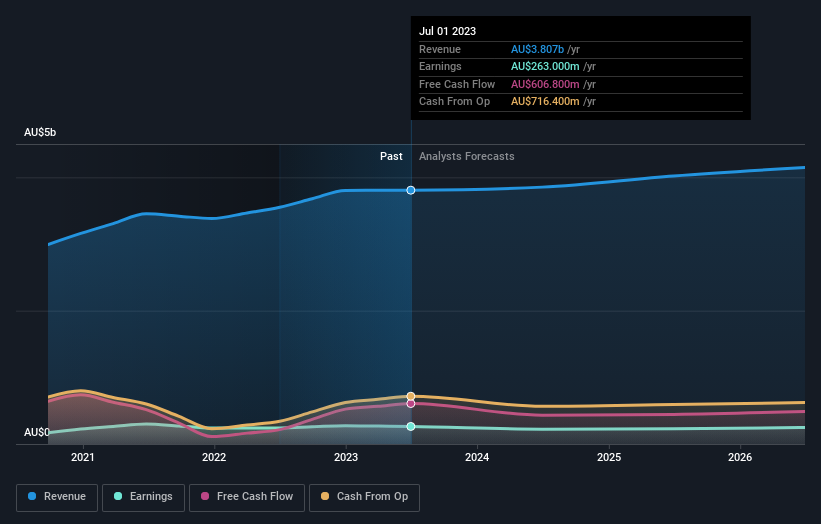- Australia
- /
- Specialty Stores
- /
- ASX:SUL
Super Retail Group Limited's (ASX:SUL) market cap rose AU$122m last week; retail investors who hold 41% profited and so did insiders

Key Insights
- Super Retail Group's significant retail investors ownership suggests that the key decisions are influenced by shareholders from the larger public
- The top 10 shareholders own 51% of the company
- Insiders have bought recently
If you want to know who really controls Super Retail Group Limited (ASX:SUL), then you'll have to look at the makeup of its share registry. The group holding the most number of shares in the company, around 41% to be precise, is retail investors. In other words, the group stands to gain the most (or lose the most) from their investment into the company.
Following a 4.2% increase in the stock price last week, retail investors profited the most, but insiders who own 30% stock also stood to gain from the increase.
In the chart below, we zoom in on the different ownership groups of Super Retail Group.
See our latest analysis for Super Retail Group

What Does The Institutional Ownership Tell Us About Super Retail Group?
Many institutions measure their performance against an index that approximates the local market. So they usually pay more attention to companies that are included in major indices.
As you can see, institutional investors have a fair amount of stake in Super Retail Group. This suggests some credibility amongst professional investors. But we can't rely on that fact alone since institutions make bad investments sometimes, just like everyone does. If multiple institutions change their view on a stock at the same time, you could see the share price drop fast. It's therefore worth looking at Super Retail Group's earnings history below. Of course, the future is what really matters.

Hedge funds don't have many shares in Super Retail Group. The company's largest shareholder is Reginald Rowe, with ownership of 28%. In comparison, the second and third largest shareholders hold about 5.0% and 4.9% of the stock.
We also observed that the top 10 shareholders account for more than half of the share register, with a few smaller shareholders to balance the interests of the larger ones to a certain extent.
Researching institutional ownership is a good way to gauge and filter a stock's expected performance. The same can be achieved by studying analyst sentiments. Quite a few analysts cover the stock, so you could look into forecast growth quite easily.
Insider Ownership Of Super Retail Group
The definition of an insider can differ slightly between different countries, but members of the board of directors always count. The company management answer to the board and the latter should represent the interests of shareholders. Notably, sometimes top-level managers are on the board themselves.
Most consider insider ownership a positive because it can indicate the board is well aligned with other shareholders. However, on some occasions too much power is concentrated within this group.
It seems insiders own a significant proportion of Super Retail Group Limited. It is very interesting to see that insiders have a meaningful AU$893m stake in this AU$3.0b business. Most would be pleased to see the board is investing alongside them. You may wish to access this free chart showing recent trading by insiders.
General Public Ownership
With a 41% ownership, the general public, mostly comprising of individual investors, have some degree of sway over Super Retail Group. While this group can't necessarily call the shots, it can certainly have a real influence on how the company is run.
Next Steps:
I find it very interesting to look at who exactly owns a company. But to truly gain insight, we need to consider other information, too. Consider for instance, the ever-present spectre of investment risk. We've identified 2 warning signs with Super Retail Group (at least 1 which is concerning) , and understanding them should be part of your investment process.
If you are like me, you may want to think about whether this company will grow or shrink. Luckily, you can check this free report showing analyst forecasts for its future.
NB: Figures in this article are calculated using data from the last twelve months, which refer to the 12-month period ending on the last date of the month the financial statement is dated. This may not be consistent with full year annual report figures.
New: Manage All Your Stock Portfolios in One Place
We've created the ultimate portfolio companion for stock investors, and it's free.
• Connect an unlimited number of Portfolios and see your total in one currency
• Be alerted to new Warning Signs or Risks via email or mobile
• Track the Fair Value of your stocks
Have feedback on this article? Concerned about the content? Get in touch with us directly. Alternatively, email editorial-team (at) simplywallst.com.
This article by Simply Wall St is general in nature. We provide commentary based on historical data and analyst forecasts only using an unbiased methodology and our articles are not intended to be financial advice. It does not constitute a recommendation to buy or sell any stock, and does not take account of your objectives, or your financial situation. We aim to bring you long-term focused analysis driven by fundamental data. Note that our analysis may not factor in the latest price-sensitive company announcements or qualitative material. Simply Wall St has no position in any stocks mentioned.
About ASX:SUL
Super Retail Group
Engages in the retail of auto, sports, and outdoor leisure products in Australia and New Zealand.
Flawless balance sheet, undervalued and pays a dividend.


